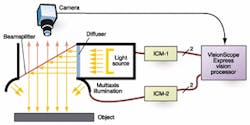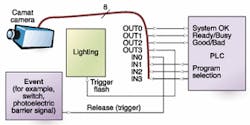LED lighting devices add smart controls
By Andrew Wilson,Editor
Perhaps the most important design parameter in developing a machine-vision system is the correct type of lighting. Today, systems integrators can select from a number of illumination technologies, including fiberoptic, fluorescent, and light-emitting diodes (LEDs), in a number of configurations, such as ringlights, spotlights, backlights, and diffuse lights.
In many machine-vision systems, the benefits of flicker-free LED lighting coupled with its low-power requirements and long lifetime have made this technology the premiere choice. An additional advantage is that most LEDs operate in the red and near-infrared range, where silicon-based CCD sensors provide their highest sensitivity. However, despite the number of LED choices now available, setting and controlling the illumination level of LED lighting is still a major problem for systems integrators. When different parts require different illumination levels, for example, it is necessary in many vision applications for a technician to manually adjust the illumination level.
Such manual adjustment is not only tedious and time-consuming, but it is prone to errors if not performed by a skilled technician. Recognizing these problems, machine-vision lighting vendors are now adding intelligence to their lighting products either by building stand-alone intelligent control modules or through strategic marketing agreements with machine-vision systems designers.
"The most effective way to alleviate the machine technician of lighting control functions," says John Merva, general manager of RSVI/Northeast Robotics (NER; Weare, NH), "is to use the vision system to control the lighting. And, since many of today's vision systems have I/O ports, sophisticated control systems can be added without significantly increasing the cost of the system."
In this way, the user interface of the machine-vision system can be used to manually control the lighting. Alternatively, such systems could be set up to automatically analyze the histogram of acquired images, as well as to determine whether the images are too dark or light and automatically adjust the lighting until the histogram is within a certain predetermined limit.
Control Modules
To control the light intensity or strobe pulsewidth of the range of Nerlite LED illuminators, NER's latest Intensity Control Modules (ICMs) feature both manual and digital control modes. In manual mode, light intensity is adjusted by a potentiometer that is accessible through a port in the side of the unit. In digital mode, light intensity is controlled from a vision-system or computer controller through standard TTL digital signaling and offers adjustment through a 100-step range. The ICM's digital mode also provides a system-level feedback loop that lets the vision system adjust the light intensity without user intervention, automatically compensating for changing illumination needs. This adjustment is especially useful in situations where there may be multiple parts on a production line, each with varying surface features.
In a typical vision application, a diffuse on-axis light (DOAL) module could be used in conjunction with a darkfield ring illuminator to highlight areas of the object that cannot be imaged with a single lighting solution (see Fig. 1). Using a DOAL module, light rays are reflected from the unit's beamsplitter directly onto the object at nearly 90°. This approach illuminates the specular surfaces perpendicular to the camera, while those surfaces at an angle to the camera appear dark. Alternatively, to enhance the contrast of surface features, such as laser embossed or engraved marks or surface defects, the darkfield ring illumination module should be used.
Camera control
"With the advent of intelligent cameras and vision systems from Cognex Corp. (Natick, MA), Omron Electronics (Schaumburg, IL), and others," says James O'Hanley, vice president of sales and marketing of CCS America (Waltham, MA), "there is a need for lighting and machine-vision manufacturers to cooperate in developing intelligent lighting solutions." As a step in this direction, CCS announced a joint venture with Omron at the recent International Robots & Vision Show that allows the company's range of LED illumination products to be controlled automatically from either the Omron F-150 or F-160 series of machine-vision sensors. Alternatively, both the F-150/160 and LED lighting devices can be preconfigured on a host PC using the company's Vision Composer Software (see Vision Systems Design, July 2001, p. 9).
FIGURE 2. Omron's intelligent lighting option links the company's F-150 Vision Sensor and its vision sensor and intelligent lighting adapter. Using a purpose-built intelligent lighting adapter allows a range of LED lighting from CCS America to be controlled in a number of different ways. For example, the intelligent lighting adapter can be linked with the CCS LDL series of rectangular oblique light illumination units. Then, using the F-150 programmable console, the lighting can be adjusted to use direct, reflected,or diffused light to obtain more information form the image being illuminated
At the same show, Omron displayed an intelligent lighting option along with the F-150 Vision Sensor. To link camera, vision sensor, and intelligent lighting adapter, a proprietary interface is used to transfer RS-170 video data to the camera as well as serial lighting control data.
An intelligent lighting adapter controls the range of LED lighting devices from CCS in several ways. For example, the intelligent lighting adapter can be linked with the CCS LDL series of rectangular oblique light illumination units. Then, using the Omron F-150 programmable console, the lighting can be adjusted for direct light, reflected light, or diffused light to obtain more information form the image being illuminated (see Fig. 2).
"Cognex has taken a slightly different approach to the issue of lighting control," says O'Hanley, "where any changes that need to be made for lighting conditions and speed need to be controlled through the camera. With this in mind, CCS has developed an interface that connects the output voltages from Cognex Insight 1000, 2000, or 3000 sensor systems to CCS lighting devices. The I/O terminals between the camera and the interface are then used to set the lighting level to the desired intensity. To supply an integrated lighting platform, Cognex is reselling 35 CCS lighting devices and the illumination controller to systems developers worldwide.
Like Cognex's Insight sensors, the Camat camera image-processing system from Vision and Control (Suhl, Germany) can also function without a PC. It uses an onboard 32-MHz ADSP2181 DSP from Analog Devices (Norwood, MA) with onboard software to program testing sequences using a hand-held keypad for image acquisition, camera calibration, and lighting. In the Camat system, digital optoisolated inputs and outputs can control lighting devices and programmable logic controllers (PLCs).
In a typical vision-system configuration, developers can configure Vision and Control's Vicolux LED lighting components with the Camat camera. In such systems, an integrated driving circuit with a brightness control integrated into the LED's aluminum casing can be powered from the 12- to 24-V output voltages of the Camat camera. Moreover, flash illumination can be triggered by TTL or PLC output levels (see Fig. 3).
Strobe lighting
Despite the benefits of long lifetime, low power consumption, and flicker-free operation, LED lighting can provide less illumination than other lighting types can. To overcome this limitation and to image fast-moving objects, several manufacturers offer strobed LED lighting systems. With such pulsed lighting, moving images can be frozen, and the scene's depth of field can be increased.
Imasys (Suresnes, France), for example, has developed the Imastrobe. This self-contained LED strobing management system includes a 150-W power supply that can strobe LEDs from 1 µs to 1 s in 1-µs increments (see Fig. 4). By limiting the lighting power supply to operate only at image-acquisition time, the system can pulse LED lights up to 3 A at 50 V or more than 6 A at 24 V. In operation, the Imastrobe can store a user's configuration and be configured from a host computer over an RS-232 link. For triggered operation, the user can choose a range of modes such as one-shot, burst, delay, or intermittent operation.
The Schott-Ultra LX Interface unit from Schott-Fostec (Auburn, NY) also operates under computer control to command lightheads and monitor input voltage, temperature, and light output. As well, the unit allows systems developers to regulate current to compensate for degradation of LED output over time, self-heating, and ambient temperature changes. With an input control voltage of 0 to 5 Vdc, the unit can continuously illuminate or strobe LED lightheads at rates to 50 kHz.
In operation, the Ultra LX interface unit provides four analog I/O channels: one input and three output that represent lighthead current drive, lighthead temperature, light intensity, and overall lighthead voltage. Using the two analog outputs of light and temperature, system developers can write programs to manage light output, which minimizes the effects of temperature change and degradation over time. They can code the third analog output (voltage) to perform systems checks and to alert the technician (or system) of LED failures within the lighthead. In addition, the interface allows strobe duration programming up to 50 kHz, current input values to overdrive the system up to 5X (depending on which head is connected), and increasing light output by 300% for strobe or 150% for continuous applications.
Managing light output is also the aim of the Signatech microprocessor-based controllers from Advanced Illumination (Rochester, VT). Designed to maximize the output of LED illuminators using a protection feature that prevents lights from being overdriven, the controllers read identification elements wired into the company's range of LED lights and, based on user preferences, prioritize either duty cycle or current to maintain safe operating parameters. In situations when the settings exceed the light's maximum limit, such as when current is the priority, the controller adjusts the duty cycle to the light's highest limit; likewise, if duty cycle is the priority, the controller adjusts the current.
Programmable through an RS-232 port, the controllers come with a 32-bit Windows-based interface that provides four-channel control with a maximum current setting of 4 A. According to Bill Thrailkill, president of Advanced Illumination, the controllers offer a pulsewidth as low as 1 µs, with better than a ±1% pulse-to-pulse regulation. All settings remain active until either a different lighthead is attached or until the controller is reprogrammed. When the controller is powered down, its settings are saved.
With a lifetime of greater than 50,000 hours, LED light sources enable objects to be illuminated with almost constant brightness. Furthermore, their insensitivity to shock and low heat dissipation makes them well suited for harsh environments and product-sensitive machine-vision applications. Coupled with intelligent interfaces that can automatically change and reconfigure illumination levels, LED illumination devices are expected to remain as the preferred lighting technology for the machine-vision industry.
Company Information
Due to space limitations, this Product Focus does not include all the manufacturers of the described product category. For information on other suppliers of lighting and illumination devices, see the 2001 Vision Systems Design Buyers Guide (Vision Systems Design, Feb. 2001, p. 68).
Advanced Illumination
Rochester, VT 05767
Web: www.advancedillumination.com
Analog Devices Inc.
Norwood, MA 02062
Web: www.analog.com
CCS America Inc.
Waltham, MA 02453
Web: www.ccsamerica.com
Cognex Corp.
Natick, MA 01760
Web: www.cognex.com
Imasys
Suresnes, France
Web: www.imasys.fr
Omron Electronics Inc.
Schaumburg, IL 60173
Web: www.omron.com/oei
RSVI/Northeast Robotics
Weare, NH 03281
Web: www.nerlite.com
Schott-Fostec
Auburn, NY 13021
Web: www.schott-fostec.com
Vision and Control
Suhl, Germany
Web: www.vision-control.com




